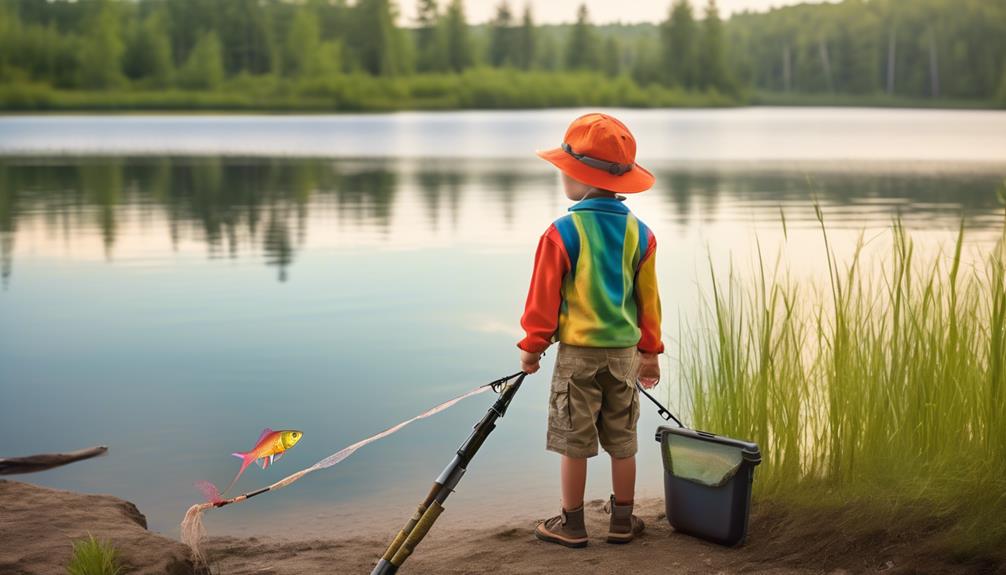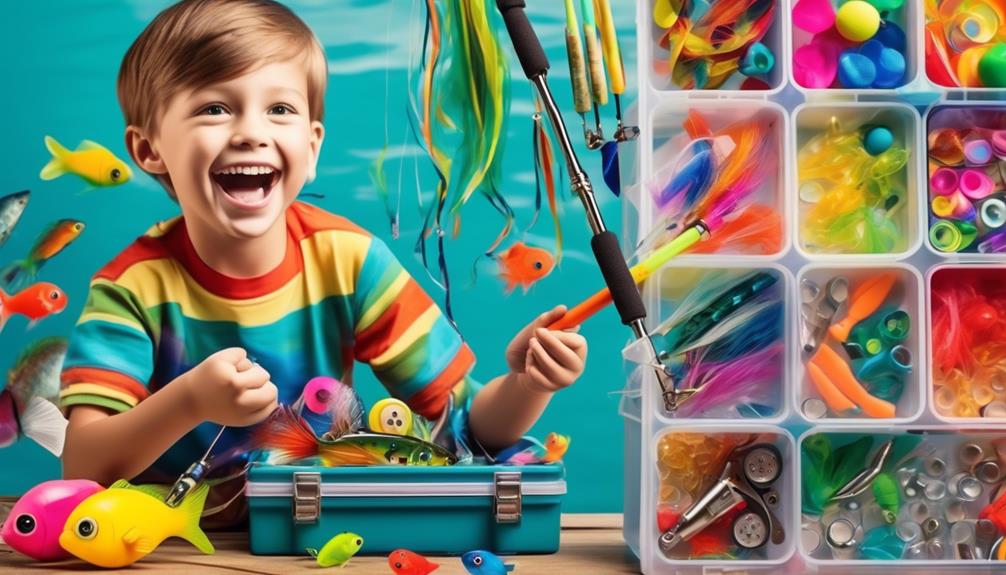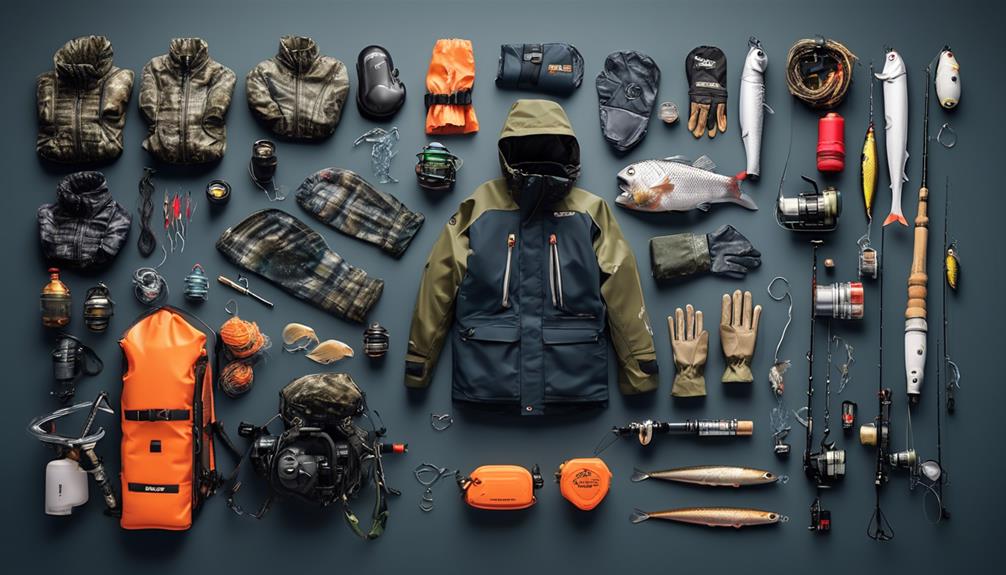Are you looking to introduce your child to the wonderful world of fishing, but not sure where to start?
Getting your little one a starter kit designed specifically for kids can be the perfect way to ignite their interest in this timeless pastime.
From the basic essentials to the fun accessories, there's a lot to consider when putting together a fishing kit for your child.
But fear not, as we'll walk you through everything you need to know to ensure your young angler has a successful and enjoyable fishing experience.
Rod and Reel Combo
Choosing the right rod and reel combo is essential for getting started with fishing. It's important to consider the type of fishing you'll be doing and the species you'll be targeting.
When it comes to rod maintenance, keeping your rod clean and free of debris is crucial. Check for any nicks or scratches on the rod, as these can weaken the rod over time.
As for casting techniques, practice makes perfect. Start with short casts and gradually work your way up to longer distances. Pay attention to your wrist and arm movements, and remember to release the line at the right moment to achieve the best cast.
When it comes to reel care, regular cleaning and lubrication are key to keeping your reel in top condition. Make sure to remove any dirt or sand that may have accumulated, and use a reel lubricant to keep the gears running smoothly.
Proper handling techniques are also important to prevent damage to your reel. Always use two hands when casting, with one hand on the rod and the other on the reel. When reeling in a fish, avoid jerky movements and maintain a steady, even pressure on the line.
Tackle Box Essentials
When stocking your tackle box with essentials, make sure to include items for maintaining your rod and reel, such as cleaning tools and lubricants to keep them in top condition. Additionally, organizing your tackle box efficiently and customizing it to your needs will help ensure a successful fishing trip.
Here are four essential items to consider for your tackle box:
- Fishing Knot Tying Techniques: It's crucial to have a good grasp of basic fishing knot tying techniques. Keep a small booklet or guide in your tackle box to reference different knots for various fishing scenarios.
- Basic Tackle Box Organization: Invest in small, adjustable dividers or containers to keep your tackle box organized. Separating hooks, sinkers, and lures will save you time and frustration while out on the water.
- Choosing the Right Bait: Have a selection of various baits in your tackle box, such as artificial lures, live bait, and soft plastics. Ensure you have options for different types of fish you may encounter.
- Tackle Box Customization: Customize your tackle box to fit your fishing style. Add a small pair of scissors or clippers for cutting line, extra bobbers, and a small first aid kit in case of accidents.
Beginner's Lures and Baits
New anglers can start their fishing journey by selecting versatile lures and baits that cater to a variety of fish species. When it comes to bait selection, live bait such as worms, minnows, and crickets are excellent choices for beginners. They're readily available at bait shops and are irresistible to many types of fish. Another option is synthetic bait, like soft plastic worms or grubs, which come in various colors and mimic the movement of live bait. These are easy to use and can attract a wide range of fish, making them a great addition to any beginner's tackle box.
As for lure presentation, it's essential to understand the basics of how to use them effectively. If you're using spinners or spoons, a steady retrieve with occasional pauses can mimic the movement of small fish, attracting predatory species. Crankbaits, on the other hand, are designed to dive and wobble, imitating injured baitfish. Mastering the art of casting and retrieving these lures can greatly improve your chances of catching fish.
Additionally, topwater lures like poppers or floating lures create surface commotion, enticing fish to strike. Understanding the behavior of different types of lures and practicing their presentations in various water conditions will help you become a more successful angler.
Fishing Line and Hooks
Selecting the appropriate fishing line and hooks is crucial for ensuring a successful and enjoyable fishing experience. When setting up your kids' fishing starter kit, consider the following key factors to make the best choices:
- Line strength: The fishing line's strength is essential to handle the weight and size of the fish you aim to catch. For beginners, a monofilament line with a test strength of 6-10 pounds is versatile and easy to handle.
- Hook size: Matching the hook size to the type of fish and bait being used is crucial. Smaller hooks (size 6-10) are suitable for catching panfish and trout, while larger hooks (size 1-3) are better for bass and catfish.
- Knot techniques: Teach your kids basic knot tying techniques such as the improved clinch knot or Palomar knot. These knots are easy to learn and provide reliable strength to secure the hook to the line.
- Bait types: Different baits require different hooks and setups. For example, live bait like worms or minnows may require a bait hook, while artificial lures can be used with treble hooks. Understanding the type of bait and its interaction with the hook will enhance your kids' fishing experience.
Safety and Protective Gear
To ensure the safety of your kids while fishing, it's essential to equip them with appropriate protective gear such as life jackets and sun protection. When spending a day out on the water, it's crucial to shield your kids from the harsh sun rays. Outfit them with wide-brimmed hats, UV-protective sunglasses, and sunscreen with a high SPF rating. Additionally, make sure they wear lightweight, long-sleeved clothing to cover their arms and legs. Proper footwear is also essential to protect their feet from sharp objects and provide good grip on slippery surfaces.
Furthermore, having a well-stocked first aid kit is paramount for any fishing trip. Accidents can happen, and being prepared with basic medical supplies can make a significant difference in addressing minor injuries promptly. Ensure the first aid kit includes adhesive bandages, antiseptic wipes, gauze pads, tweezers, and any necessary medications. Familiarize your kids with the contents of the first aid kit and how to use them in case of emergencies.
Lastly, never overlook the importance of life jackets. Even if your kids are confident swimmers, unexpected situations can arise. Ensure that they wear properly fitted life jackets at all times when near or on the water. Encourage them to embrace this safety measure as a non-negotiable aspect of their fishing experience.
Knot-Tying Tools
Ensuring the safety of your kids while fishing also involves having the right tools for knot-tying. Proper knot tying techniques require practice, and having the right tools can make the learning process easier and more enjoyable for your kids.
Here are some different knot tying tools and options to consider:
- Practice Knot Boards: These boards feature grooves and holes for practicing various knot tying techniques. They're a hands-on way for kids to learn and master different knots before applying them in actual fishing situations.
- Knot-Tying Tools with Built-in Guides: Some knot-tying tools come with built-in guides that assist kids in creating the perfect knot every time. These tools are designed to simplify the knot-tying process, making it easier for kids to learn and remember the steps.
- Knot-Tying Cards: These cards provide step-by-step instructions for tying different knots. They're compact and can easily be carried in a pocket or tackle box, allowing kids to refer to them whenever they need a refresher on a particular knot.
- Interactive Knot-Tying Apps: With advancements in technology, there are now interactive apps available that teach kids various knot tying techniques. These apps often include games and challenges to make learning knots fun and engaging for kids.
Landing Nets and Fish Grippers

Consider using a sturdy landing net to safely handle the fish you catch. A landing net is an essential tool for young anglers to safely bring in their catch without harming the fish or risking injury to themselves.
When choosing a landing net for kids, look for one with a soft mesh material that's gentle on the fish's scales and fins. This will help minimize stress and potential harm to the fish during the handling process. Additionally, a rubber-coated net is ideal for catch release, as it reduces the likelihood of the fish getting tangled in the net.
Fish grippers are another useful tool for ensuring proper fish handling. These grippers allow young anglers to securely hold onto the fish without squeezing too tightly, reducing the risk of injury to both the fish and the angler.
When using fish grippers, make sure to grasp the fish gently and avoid putting excessive pressure on its body. This will help to minimize any potential harm to the fish and make the catch release process smoother and safer.
Both landing nets and fish grippers play a crucial role in promoting responsible fishing practices among young anglers. By using these tools, kids can safely handle their catches and ensure a successful catch release, contributing to the conservation of fish populations for future generations of anglers.
Fishing Accessories for Kids
When outfitting kids for their fishing adventures, it's essential to equip them with the right accessories. Fishing rods and tackle boxes are necessary to complement their landing nets and fish grippers for a complete angling experience. To ensure a fun and successful fishing trip for your little angler, consider these must-have fishing accessories for kids:
- Kids' Fishing Vests and Fishing Gear Storage: A proper fishing vest designed for kids not only adds to the excitement of the fishing expedition but also provides ample storage for small fishing essentials like hooks, lures, and bait. Look for vests with multiple pockets and adjustable straps to fit your child comfortably.
- Child-Friendly Fishing Hats: Protecting your child from the sun is crucial during fishing trips. Child-friendly fishing hats not only shield their face and neck from harmful UV rays but also add to the overall fishing experience. Opt for hats with wide brims and adjustable chin straps to ensure they stay securely on your child's head.
- Sunglasses for Kids: Invest in a good pair of polarized sunglasses for your child to shield their eyes from the sun's glare while providing better visibility into the water. Look for sunglasses specifically designed for kids, featuring durable frames and UV protection.
- Fishing Gear Storage: Consider getting a small tackle box or bag designed for kids to keep their fishing gear organized. It will teach them the importance of keeping their equipment tidy and easily accessible, fostering good angling habits from the start.
Equipping your child with these fishing accessories won't only ensure their safety and comfort but also contribute to a memorable and enjoyable fishing experience.
Frequently Asked Questions
What Are Some Common Mistakes That Kids Make When They First Start Fishing?
When kids first start fishing, common mistakes include not being patient, forgetting to bring essential gear, and not paying attention to fishing etiquette.
With parental support, you can help them learn proper casting techniques and the importance of respecting nature and other anglers.
How Can Parents Help Their Kids Stay Patient and Focused While Fishing?
To help your kids stay patient and focused while fishing, try using mindfulness techniques. Encourage them to pay attention to their surroundings and be present in the moment.
Positive reinforcement techniques can also be effective – praise them for their efforts and progress, and offer rewards for staying focused.
It's important to make fishing an enjoyable and rewarding experience for them, which will help them stay engaged and patient.
Are There Any Specific Techniques or Tips for Helping Kids Learn How to Cast Properly?
When teaching kids how to cast properly, start with casting practice in an open area. Show them the proper grip on the casting equipment and teach them to hold the rod firmly but not too tight.
Use teaching techniques like visual demonstrations and hands-on guidance. Encourage them to practice consistently and be patient.
Positive reinforcement and praise for their progress will help them build confidence in their casting skills.
What Are Some Fun and Educational Games or Activities to Help Kids Learn About Different Fish Species and Habitats?
To learn about fish species and habitats, you can engage in a variety of activities.
- Play games like 'Fish Bingo' or 'Guess the Fish' to increase your knowledge and understanding.
- Take field trips to local ponds or aquariums to explore different habitats and observe fish in their natural environments.
- Create a 'Fish of the Week' activity where you research a new species together and learn about its habitat and characteristics.
- Make a fish tank and observe the behavior of the fish, noting how they interact with their environment.
- Engage in nature scavenger hunts to find different habitats and discover the variety of fish species that reside in each one.
These activities combine fun and education, making the process of learning about fish species and habitats enjoyable and engaging.
How Can Kids Learn About Conservation and Responsible Fishing Practices?
To learn about conservation education and ethical angling practices, start by understanding the importance of protecting fish habitats and the environment.
Teach kids about catch and release practices, and the impact of overfishing. Encourage them to use barbless hooks and proper fish handling techniques.
Engage in discussions about the importance of conservation and the role of responsible fishing in sustaining the natural ecosystem.
Model and explain the significance of following fishing regulations.
Conclusion
Now that you have all the essential gear for your kids' fishing adventure, it's time to hit the water and start casting!
Remember to teach them proper safety measures and how to handle their catch with care.
With the right equipment and a little guidance, your kids will be reeling in fish and making memories that will last a lifetime.
Happy fishing!



